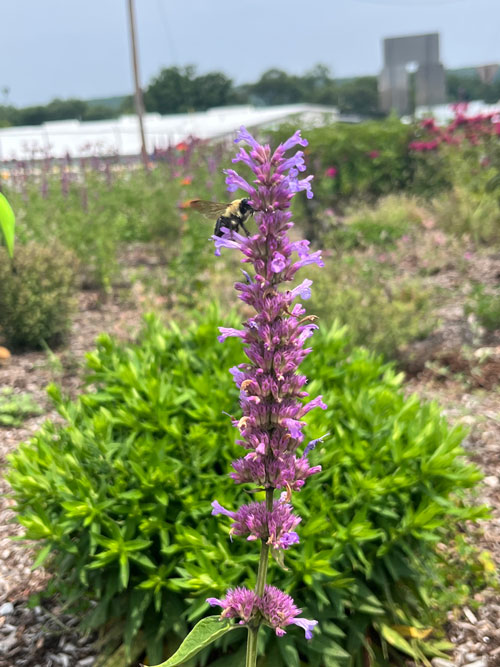By Liz Nye, New England Botanic Garden Staff
July 2023

Bumblebee (Bombus spp.) sipping nectar at a beebalm (Monarda ‘Raspberry Wine’) flower at the Lincoln St rotary; Photo by Ashley Gatongo
Wildlife sightings in busy cities can sometimes be surprising. Just take the recent images of a bobcat padding through the yard of a home in Worcester. Despite all the hardscaping, urban environments can support a diverse array of creatures if the right habitat and food resources are present.
While bobcats and other large mammals are rare, pollinators can be plentiful. Insect pollinators are some of the easiest animals to host in a residential or urban landscape. The entire lifecycle of some insect species can be fulfilled in a single small, well-planted space. For others, pockets of vegetation distributed across the urban landscape can provide essential resources.
“Bumblebees are often first to arrive when we’re planting,” says Amy Nyman, New England Botanic Garden’s horticulture outreach manager. Amy oversees the Garden’s urban greening initiatives, programs that partner with community-based organizations in Worcester on urban forestry projects and plant-based solutions to climate change. Urban greening initiatives establish plants in places that on first glance might seem inhospitable to wildlife. Worcester rotaries, medians, sidewalks, and even yards at commercial properties are transformed by the addition of trees, shrubs, and flowering perennials.
For people and pollinators, the creation and maintenance of green spaces within cities has never been more important. Plants shape the microclimates around them. As people continue to burn fossil fuels, we release excessive amounts of carbon dioxide into the atmosphere where it acts like a heat trapping blanket getting thicker and thicker. This summer, Earth saw its highest average daily temperature ever, a record-setting day that was immediately matched by the day that followed. The realities of climate change—extreme heat, sea level rise, biodiversity loss, and more—can at times seem like problems too big and complex to solve. Looking locally for opportunities to make change helps.
In the face of a hotter planet, the Garden’s urban greening initiatives go beyond beautification to benefit the urban ecosystem and the people who are part of it. Greening projects designed with large amounts of native plants such as butterfly milkweed (Asclepias tuberosa), anise hyssop (Agastache foeniculum), bee balm (Monarda spp.), sweet-gum trees (Liquidambar styraciflua), and many more, provide important food and habitat resources for birds and insects. This summer, Garden staff and interns have spotted butterflies, beetles, wasps, and countless bumblebees making use of urban greening project sites. Gardens in cities also help mitigate stormwater.

Least skipper (Ancyloxypha numitor) at the Lincoln Street rotary; Photo by Amy Nyman
And as the trees and other plants in these spaces grow, they will provide shade to sidewalks and buildings. Shaded surfaces can be 20 to 45 degrees cooler than unshaded surfaces. Transpiration, a process of water excretion used by plants, also contributes to this localized cooling.
Trees provide the most “bang for your buck” when it comes to these and other benefits, but some city streets lack designated tree wells or other medians available for planting. The Garden’s Planters for People program, another of its urban greening initiatives, addresses this problem by placing large scale planters directly on sidewalks and filling them with trees, shrubs, and flowering plants. The program was first piloted in 2021 with six planters in Worcester’s Main South neighborhood. Over the past two years, it has grown to include new partners and new locations. In total, 35 planters are planned for Main South and Pleasant Street this year. “Even the smallest project site serves as a waystation for pollinators and a steppingstone toward better resiliency in the face of climate change,” Amy says.

Bumblebee (Bombus spp.) approaching calamint (Clinopodium nepeta subsp. spruneri ‘White Cloud’) planted in one of the Pleasant Street Planters for People; Photo by Hunter Blanchard
The Garden’s greening projects rely on community partnerships that engage residents in environmental stewardship now and, hopefully, into the future. Planters for People, for example, is a collaboration with the Main South CDC, Regional Environmental Council, and Pleasant Street Neighborhood Network Center. In addition to these community partners, urban greening initiatives are made possible by the Garden’s dedicated team of horticulture staff, summer interns, and volunteers. Throughout the rest of the summer, this team will do its best to photograph pollinator visitors to Planters for People sites and to greening locations across Worcester.
We’ll post photos of more pollinators we spot foraging to social media so follow us @NewEnglandBG and feel free to share or tag us in any photos you might take from these sites!









